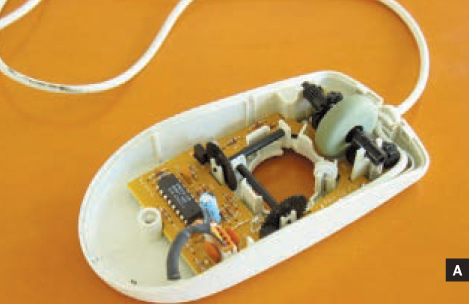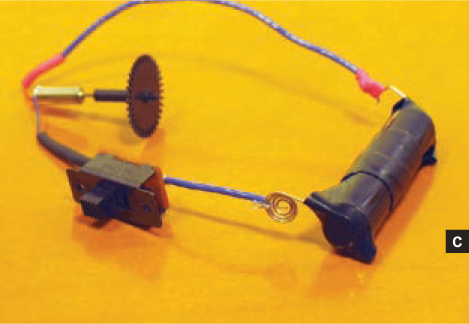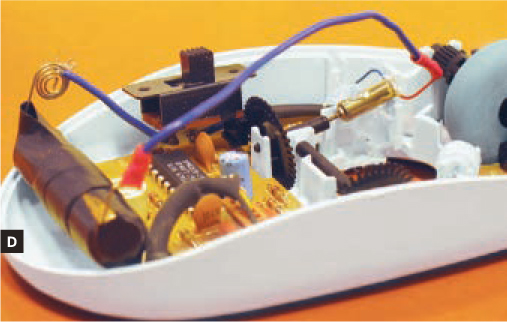
Photograph by Sam Murphy
EVIL MOUSE PRANK
 Control your co-worker’s cursor!
Control your co-worker’s cursor!
Joe Bowers is sneaky, resourceful, and rotten to the core. Whatever you do, don’t get in a prank war with him.
Returning to my desk from a coffee break, I sat down, grabbed my mouse, and ... nothing. The cursor was stuck to the left wall of my monitor. I shook my mouse wildly. The cursor moved up and down just fine. But when I jerked my mouse viciously to the right, the cursor nudged a little, then slammed back to its new favorite position, clinging maddeningly to the leftmost pixel.
Blowing on the mouse’s nether regions didn’t help, so my officemate, Hide Yosumi, took pity on me. “Do you hear something?” he asked knowingly. There was a high-pitched whine coming from behind my workstation. I looked and saw that a strange mouse was plugged in. Not just any mouse. A prank mouse.
Like most analog mice, it once used a ball to drive the shafts of a pair of rotary encoders (disks with notches cut into their edges). Spinning an encoder breaks an IR beam, which drives cursor movement.

Fig. A: Regular old optomechanical mouse guts.

Fig. B: The rotary encoder disk mated to a motor.

Fig. C: The battery, switch, and motor circuit. Why buy a battery box when you’ve got electrician’s tape?

Fig. D: Everything in its place, ready to spin the cursor to the left-hand side.
Photography by John Edgar Park
Joe had attached a DC motor to the x-axis encoder disk (hence the noise). My confused computer thought someone was sprinting the mouse down an infinitely long table. My attempts to budge the cursor were overwhelmed by this much-harder-working prank mouse. I’m honored to have been so cleverly pranked, Joe.
How It’s Done
1. Get an old mouse that uses a ball, rather than an optical sensor. Peel any stickers off the mouse’s underbelly, looking for screws. Remove these and pry the mouse open. Remove the ball and save it in your jar of spherical things.
2. Pull a DC motor from an old toothbrush or toy helicopter. Based on the size of your motor, measure where to cut the x-axis encoder shaft, then carefully remove the encoder.
3. Cut the excess shaft off with a knife. Here’s the tricky part — mating the encoder shaft to the motor shaft. I “drilled” into the plastic shaft end with a pin, making a starter hole. Then I heated the metal motor shaft with a lighter until it glowed red, and pressed it into the plastic shaft.
4. I wired my motor to a switch and AAA battery. You could add a variable resistor to adjust cursor speed; a slow drift would be really evil. Joe was pressed for time (he built this prank during lunch, the fiend!) so he seems to have used glittery hot glue for all the fabrication. You should solder and heat-shrink your connections to avoid shorting things out.
5. Snap the encoder in place, then mount the motor to the mouse housing. Taking a cue from Joe, I resorted to hot glue, too.
6. Switch on the motor and plug the mouse into your victim’s computer when they aren’t looking. Listen for the screams of cursorial frustration to ring through the halls.
Please send any counter-prank ideas my way.
John Edgar Park ([email protected]) is a character mechanic at Walt Disney Animation Studios and host of the upcoming PBS television series, Make:TV.
